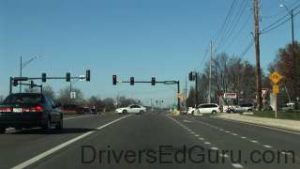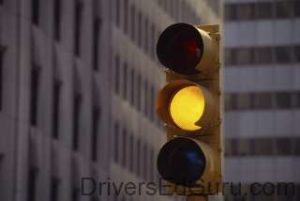Stage 3: Intersections – Part 2
Whenever your teen doesn’t have the right of way at an intersection or the intersection is uncontrolled, they’re going to have to figure out on their own when to enter the road. This is a fairly difficult task for a new driver because it requires a good sense of closure rates. In Intersections Part 1, we discussed an exercise for improving this. Assuming that your teen is now a master of closure rates, you need to teach your teen how to assess intersections.
Before we get further into the lesson, check out this video. A car runs a red light and is hit by cross-traffic. A pedestrian ends up getting hit, too. This is a perfect illustration of why you shouldn’t run a red light and why you should always wait a few seconds when a light turns green. I hope this hammers home the dangers of an intersection.

Learn what to look for at intersections
In the previous lesson, we mentioned that determining how an intersection is controlled is important because it gives you clues as to how other drivers may act. For instance, a 4-way intersection with stop signs at all four corners is much different than an uncontrolled 3-way T-intersection.
Get behind the wheel and drive to many different types of intersections and use commentary driving to explain to your teen what’s important. Here’s an incomplete list of risks, but it should get you thinking.
- Stop-sign controlled:
- 4-way stops: While 4-way intersections that are controlled by four stop signs are relatively safe, they still pose some potential problems. Drivers tend to always screw up the right-of-way rules at 4-way stops. Here’s how it works: right of way is yielded to whichever car arrives first at the intersection. If multiple cars arrive at the same time, the right of way is yielded to the car to the right. Now, that is how things are supposed to happen. What actually happens at a 4-way stop is usually much different. Teach your teen that:
- Just because there’s a stop sign, it doesn’t mean the other car is going to stop. Don’t enter the intersection unless it is clear and that any approaching cars are far enough away that they won’t hit you if they don’t stop. Otherwise, wait for those cars to come to a stop before completely crossing the intersection. Unfortunately, you can’t assume other drivers will follow the rules of the road.
- Just because you have the right of way, it doesn’t mean other cars are going to give it to you. You must look in all directions several times before proceeding into the intersection. You have to be certain that another car isn’t also crossing.
- 2-way stops: Oftentimes, drivers confuse two-way stops with four-way stops. This can have deadly consequences. Just because you have a stop sign at an intersection, it doesn’t mean that other cars must also stop. This is why it’s so important to identify how the intersection is controlled.
- 4-way stops: While 4-way intersections that are controlled by four stop signs are relatively safe, they still pose some potential problems. Drivers tend to always screw up the right-of-way rules at 4-way stops. Here’s how it works: right of way is yielded to whichever car arrives first at the intersection. If multiple cars arrive at the same time, the right of way is yielded to the car to the right. Now, that is how things are supposed to happen. What actually happens at a 4-way stop is usually much different. Teach your teen that:
- Uncontrolled intersections: These types of intersections are more common in rural areas than they are in city areas. This is due to the low traffic volume in rural areas. The risks are high at an uncontrolled intersection, so make sure your teen approaches it carefully. Right-of-way tells us that cars that are continuing straight have priority over cars turning. It also states that traffic to the right has priority. Again, you can’t trust that other drivers know these rules or that they will obey them. Therefore, do not cross an uncontrolled intersection unless you can see that the road is clear in all directions. If you’re unsure, slow down or stop.
- Signal-controlled intersections: Because these intersections typically control all of the traffic flow, many drivers discount the level of danger at these crossroads. However, signal-controlled intersections are extremely high volume and present many problems.
- Red-light runners: Teach your teen not to go on green. The reason is that more than 94 percent of red-light violations occur within 2 seconds of red light onset. You must convince your teen that not all drivers follow the rules.
- Cars making left turns: Whenever you approach an intersection, you should be especially cautious of cars making a left turn. You must keep a watchful eye on these cars to see if they’re going to turn out in front of you. You simply have no way of knowing if these cars have a protected or unprotected turn. A protected turn means that they have a green left-turn signal. An unprotected turn means they have a green light and are supposed to be yielding to oncoming traffic. As you should know by now, you can’t assume other cars will make smart (or legal) decisions.
Stale Greens
Because you’ve taught your teen proper searching and scanning techniques, they should be aware of the status of any traffic light as they approach it. This means that they should have a sense of how long a light has been green. If a light has been green for a long time, it becomes “stale”. Your teen should switch to cover braking and be prepared to stop as they approach the light.

Yellow Lights and the Point of No Return
Technically, yellow lights mean “caution”. Many drivers attempt to hurry through a yellow light before it turns red and inevitably end up running it. If the light is red and you’re in the intersection, you’ve broken the law. Teach your teen that yellow lights mean “stop unless already in the intersection”.
Of course, that definition doesn’t take into account the following scenario: What if you’re just a second away from the intersection and it turns from green to yellow? Do you risk slamming on your brakes and causing an accident or do you continue through the light?
The point of no return is used to help you make that tough decision. As you approach any intersection, teach your teen to determine a point of no return. This is a fixed point along the road that will determine if you should continue through an intersection if the light turns yellow.
The point of no return is usually determined as being 2-3 seconds before the intersection. Basically, if the light turns yellow and you haven’t yet reached this point, stop. Otherwise, continue through the intersection cautiously.
But what if you’re at the point of no return and the light change? Now what do you do? This is when you have to make a quick decision based upon the cars behind you. If a car is tailgating you, it may be necessary to continue through the intersection to avoid a rear-end crash. Otherwise, it’s probably safer to stop.
Because your teen has developed a good scanning technique by this point, they should already know the status of any cars behind them before reaching the point of no return. Therefore, the decision to stop or continue should be done quickly.
Continue on to Night Driving

